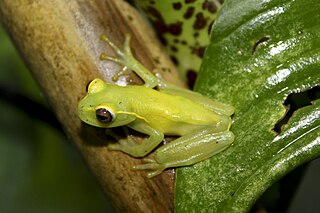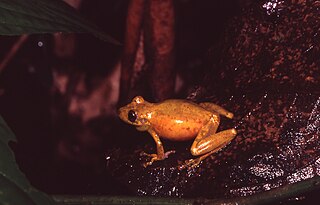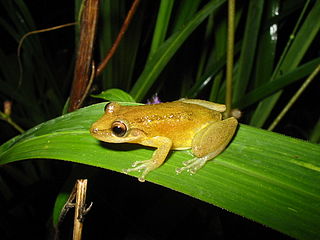Dendropsophus berthalutzae is a species of frog in the family Hylidae. It is endemic to southeastern Brazil and occurs in the coastal lowlands and the Serra do Mar in Espírito Santo, Minas Gerais, Rio de Janeiro, São Paulo, and eastern Paraná states. It is named in honor of Bertha Lutz, a Brazilian zoologist and feminist. Common name Bertha's treefrog has been coined for it.
Dendropsophus stingi is a species of frogs in the family Hylidae. It is endemic to Colombia and occurs on the eastern slope of the Cordillera Oriental in the Boyacá Department. The species was named after celebrity musician Sting in recognition of his "commitment and efforts to save the rain forest". Despite this, common name Kaplan's Garagoa treefrog has been coined for it.
Exerodonta sumichrasti is a species of frog in the family Hylidae. It is endemic to Mexico and known from the Pacific slopes of southern Mexico in the Guerrero, Oaxaca, and Chiapas states as well as from the Chiapan highlands.
Hyloscirtus chlorosteus is a species of frog in the family Hylidae. It is endemic to Bolivia and only known from the holotype collected in 1979 from Parjacti (=Paracti), on the eastern slopes of the Andes in the Cochabamba Department. The specific name refers to the green bones of this frog. Common name Parjacti treefrog has been coined for it.

The La Loma tree frog is a species of frog in the family Hylidae found in Costa Rica, Panama, and expected but not confirmed in Colombia. Its natural habitats are tropical moist lowland and montane forests, with breeding taking place in streams. It is threatened by habitat loss and chytridiomycosis.
Isthmohyla calypsa is a species of frogs in the family Hylidae. It is known from the southern Cordillera de Talamanca in Costa Rica, Cerro Pando in Costa Rica and Panama, and the Pacific slope in southwestern Panama. It appears to now be extirpated from Costa Rica. Prior to its description in 1996, this species was confused with Isthmohyla lancasteri, a species now known from lower altitudes only.
Isthmohyla debilis is a rare species of frog in the family Hylidae. It occurs in the Atlantic slopes of the Cordillera Central and Cordillera Talamanca in Costa Rica and western Panama as well as on the Pacific slopes in southwestern Panama. Common name Isla Bonita treefrog has been suggested for it.
Isthmohyla lancasteri is a species of frog in the family Hylidae. It is endemic to humid premontane slopes of the Cordillera de Talamanca in Costa Rica and western Panama.

Isthmohyla rivularis is a rare species of frog in the family Hylidae. It occurs in the cordilleras of Tilarán, Central, and Talamanca in Costa Rica as well as adjacent western Panama. The species was thought to already have become extinct, but in 2007, it was re-discovered in the Monteverde Cloud Forest of Costa Rica when a single male was found. In 2008, a gravid female and few males were spotted. The common name American Cinchona Plantation treefrog has been suggested for it.

Isthmohyla tica, also known as Starrett's treefrog, is a species of frog in the family Hylidae. It is found in the Cordillera de Tilarán, Cordillera Central, and Cordillera de Talamanca of Costa Rica and western Panama. The specific name tica is derived from the name that Costa Ricans use to refer themselves, tico.
Isthmohyla xanthosticta is a species of frogs in the family Hylidae. It is endemic to Costa Rica and only known from its type locality on the south slope of Volcan Barba in the Heredia Province. Common name south fork treefrog has been coined for it.
Nyctimystes persimilis, also known as the Milne big-eyed treefrog, is a species of frog in the subfamily Pelodryadinae of the family Hylidae. It is endemic to Papua New Guinea and known from Mount Dayman and Mount Simpson in the Owen Stanley Range.
Dryaderces pearsoni is a species of frog in the family Hylidae. Broadly defined, it is found in Bolivia, Brazil, and Peru. However, the nominal taxon includes two species, and true Dryaderces pearsoni is only known with certainty from Bolivia. The specific name pearsoni honors Nathan E. Pearson, an American ichthyologist who made a "splendid collection of amphibians" during an expedition to Bolivia, including the holotype of this species. Common name Pearson's slender-legged treefrog has been coined for the species.
Callimedusa ecuatoriana is a species of frog in the subfamily Phyllomedusinae. It is endemic to Ecuador and known from the Amazonian slopes of the Andes in the Morona-Santiago Province as well as from Cordillera del Condor in the Zamora-Chinchipe Province. Common name Agua Rica leaf frog has been proposed for it.

Scinax cruentomma is a species of frog in the family Hylidae. It is found in the upper Amazon Basin of southern Colombia, eastern Ecuador, northeastern and east-central Peru, and western Brazil; its presence is French Guiana is dispted. The specific name cruentomma is derived from the Greek cruentos meaning "bloody" and omma meaning "eye", referring to the red streak in the eye of this frog. This species is also known as the Manaus snouted treefrog.

Scinax fuscomarginatus is a species of frog in the family Hylidae. It is found in northwestern Argentina, Paraguay, eastern Bolivia, southern, central, and eastern Brazil, and in scattered localities in the lowlands of eastern Venezuela and savannas of Guyana and southern Suriname as well as adjacent Brazil. As currently defined, it is one of most widespread Neotropical frogs; the northernmost records refer to what was formerly recognized as Scinax trilineatus. Common name brown-bordered snouted treefrog has been coined for this species.
Gastrotheca abdita is a species of frog in the family Hemiphractidae. It is endemic to Peru and only known from the Cordillera Colán in the Amazonas Region. The specific name abdita is Latin for "exiled" or "removed" and refers to the geographic isolation of the Cordillera Colán. Common name Cordillera Colan marsupial frog has been coined for it.
Gastrotheca nicefori is a species of frog in the family Hemiphractidae. It is found in the Andes of Colombia, on the Andean slopes of northern Venezuela, and in the highlands of eastern and central Panama.
Gastrotheca ochoai is a species of frog in the family Hemiphractidae. It is endemic to southern Peru and occurs in the interandean valleys on the eastern face of the Andes. The specific name ochoai honors Oscar Ochoa Mendieta, a biology professor from the National University of Saint Anthony the Abbot in Cuzco who helped the species descriptors during the field work. Common name Chilca marsupial frog has been coined for this species.
Choerophryne grylloides is a small species of frog in the family Microhylidae. It is endemic to the upper Sepik River basin in the northern side of the New Guinea Highlands in Papua New Guinea. The specific name grylloides, from Latin gryllus ("cricket") and Greek suffix -oides ("resembles"), alludes to its cricket-like, high-pitched advertisement call.





